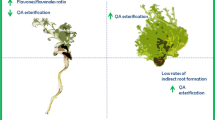Abstract
Previous studies have shown that the development anomaly encountered in meristem culture, known as ‘vitreous plants’, is due to deficient lignin synthesis. This anomaly can be cured by addition of phloridzin to the culture medium. This study examines the activities of some enzymes involved in the synthesis of lignins and of flavonoids in normal and in vitreous plants of two apple cultivars. The results showed that all enzymes were consistently less active in the vitreous plants. This agrees with previous studies made on the hydroxycinnamate: CoA ligase activity in Prunus avium (L.) meristem-derived plants. The study on the substrate specificity of the enzyme demonstrates that while its activity is lower in the vitreous plant, its conformation is identical with that of the normal plant; the substrate that is specific to enzyme extracts of both sources is para-coumaric acid.
Similar content being viewed by others
References
Bartz B, Schaffer E, Hahlbrock K (1978) A light-induced phenylalanine ammonialyase in cell suspension culture of Petroselinum hortense. Quantitative comparison of rate of synthesis and degradation. Arch Biochem Biophys 190: 126–135
Beauchesne G (1981) Les milieux minéraux utilisés en culture ‘in vitro’ et leur incidence sur l'apparation de Boutures d'aspect pathologique. C R Acad Agric, France, 67: 1389–1397
Boxus P (1978) Culture de tissus d'espèces fruitières. Rapport d'activité 1978. C R Gembloux (Belgique): 126–127
Bradford MA (1976) A rapid and sensitive method for the quantitation of microgram quantities of protein utilizing the principle of protein dye binding. Anal Biochem, 72: 248–254
Grand C, Boudet A and Boudet AM (1983) Isoenzymes of hydroxycinnamote: CoA ligase from poplar stems properties and tissue distribution, Planta, 158: 22–229
Gross GG (1980) The biochemistry of lignification, in ‘Advances in Botanical Research’, H.W. Woodhouse ed., Acad Press, vol. 8, pp 25–63
Hegedus P, Phan CT (1982) Malformation chez le pommier M-26 cultivé in vitro: action de la phloroidzine. Annales ACFAS, 49: 35
Hegedus P, Phan CT (1983) Actions de phénols sur les malformations observées chez les porte-greffes de pommiers M-26 et 0–3 cultivés in vitro. Rev Can Biol Exptl, 42: 33–38
Letouze R, Daguin F (1983) Manifestation spontanée et aléatoire d'une croissance anormale en culture in vitro. Recherche de marqueurs métaboliques. Rev Can Biol Exptl 42: 23–28
Letouze R, Daguin F (1985) Control of vitrification and hypolignification process in Salix babylonica cultured ‘in vitro’. Symp. ‘In vitro problems related to mass propagation of horticultural plants’, Gembloux, Belgium, Sept. 1985, Book of Abstract, 1. Lectures, 31
Luderritz T, Griesebach H (1981) Enzymic synthesis of lignin precursors. Comparison of cinnamoyl-CoA reductase and cinnamoyl alcohol: NADP dehydrogenase from spruce (Picea abies, L.) and soybean (Glycine max, L.), Eur J Biochem 119: 115–125
Moustafa E, Wong E (1967) Purification and properties of chalcone flavanone isomerase from soya bean seed. Phytochem 6: 625–632
Murashige T, Skoog F (1980) A revised medium for rapid growth and bio assays with tobacco tissue cultures. Physiol Plant 15: 473–497
Phan CT, Letouze R (1983) A comparative study of chlorophyll, phenolic and protein contents, and of hydroxycinnate: CoA ligase activity of normal and ‘vitreous’ plants (Prunus avium, L.) obtained in vitro. Plant Sci Letters, 31: 323–327
Ranjeva R, Alibert G, Boudet AM (1977) Metabolisme des composés phénoliques chez le Petunia. VI Intervention des chlorplastes dans le biosynthèse de la naringénine et de l'acide chlorogénique. Plant Science Letters 10: 236–242
Vieth J, Phan CT, Hegedus P (1982) Etude histologique exploratoire de régénérats vitreux de Pyrus malus, CV M-26. Ann ACFAS, 49: 91
Vieth J, Morisset C, Lamond M (1983) Hitologie de plantules vitreuses de Pyrus malus CV M-26 et de Pelargonium pelatatum CV. Chester Frank issues de la culture in vitro. Rev Can Biol Exptl 42: 29–32
Author information
Authors and Affiliations
Rights and permissions
About this article
Cite this article
Phan, C.T., Hegedus, P. Possible metabolic basis for the developmental anomaly observed in in vitro culture, called ‘vitreous plants’. Plant Cell Tiss Organ Cult 6, 83–94 (1986). https://doi.org/10.1007/BF00037761
Received:
Revised:
Accepted:
Issue Date:
DOI: https://doi.org/10.1007/BF00037761




